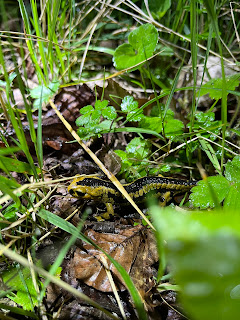Fieldwork update from Spain
My name is Nic Strowbridge, I am currently a 4th year IAPETUS PhD student in the Elmer lab. Here is a post about my fieldwork experience studying salamanders!
Spring 2024 marked the first fieldwork experience for my IAPETUS PhD. We travelled to the Principality of Asturias in Northern Spain to the Elmer lab field site near the Río Color. In this region, there is a unique population of a subspecies of the European fire salamander, S. salamandra bernardezi, which exhibits a striking diversity of colour and pattern polymorphisms. For my IAPETUS PhD project, we are examining the underlying molecular mechanisms that produce these different colour and patterns. Previous work in the lab has shown that there are gene expression differences between the colour morphs, but other molecular mechanisms may be present in determining the different colours and pattern. My work uses Oxford Nanopore sequencing to determine if other molecular mechanisms, such asRNA methylation, may play a role in colouration and whether these are related to expression differences.
For the beginning of my project, I sampled salamanders from a previous collection, however, to increase sample sizes I needed to travel to Spain to see more specimens. So, I set off in spring of this year with Kathryn Elmer and our collaborator David Vieites to search for more salamanders! Salamanders are active during the spring and autumn, particularly during wet and humid periods, so April is an ideal period. Unfortunately (or fortunately, depending on how you look at it!), the first few days upon arrival in the Asturias was clear skies, 25C and dry... not very good salamander weather, but great relaxing weather!
During the first few nights of searching (salamanders are nocturnal), I was only able to see a handful of salamanders and was losing hope that I would be able to collect the samples I needed. However, luck was on my side and on one of the last days of the trip there was enough rain during the day to encourage the salamanders to come out of their hiding spots.
During the fieldwork, S. salamandra bernardezi, weren’t the only amphibians that I spotted (see pictures). I found a diversity of amphibian life, including but not limited to common midwife toad (Alytes obstetricans), European common frog (Rana temporaria), gold-striped salamander (Chioglossa lusitanica), and palmate newt (Lissotriton helveticus), to name a few. I was even lucky enough to see other interesting animals along the roads and paths, such as a Seoane's viper (Vipera seoanei), alongside lots and lots of mice! During one of the days, I was also lucky enough to be taken on a visit to a cave where a fossilized baby rhinoceros had been found. All in all, a great experience and successful fieldwork trip for my PhD project!
See below for some pictures of the amphibians I encountered, the fossil rhino, and other interesting pictures!




.jpeg)


